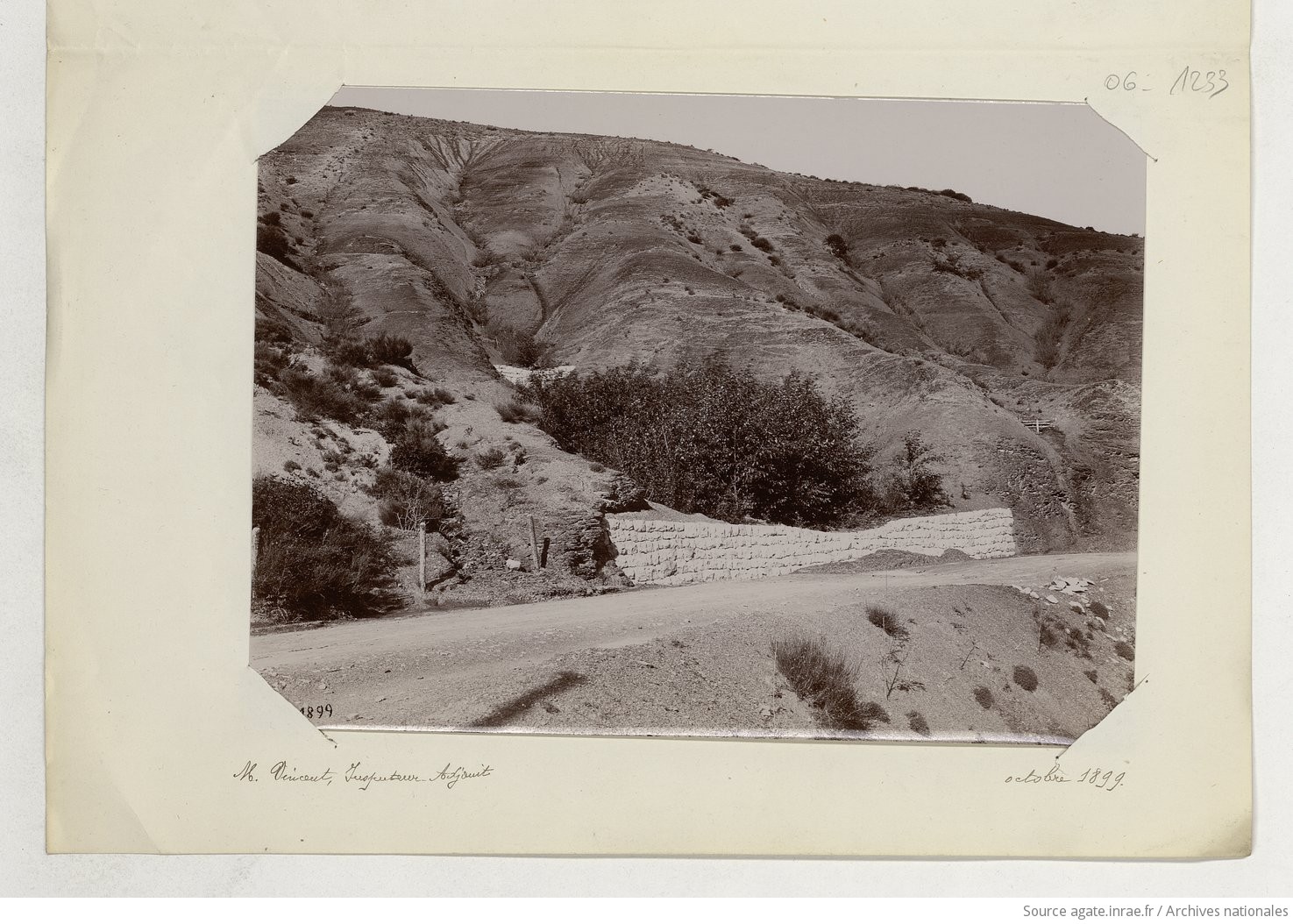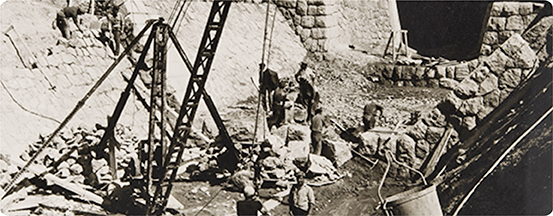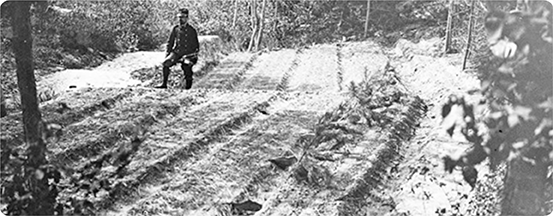Dams and weirs, indirect protection through civil engineering
Since the 1860s, government departments have been working to secure natural and human habitats threatened by erosion and mountain torrents. Civil engineering techniques are deployed to stabilise torrent beds and consolidate the banks.

The dam in question here is a "check" dam. Its purpose is not to retain water, but to stabilise the torrent bed, consolidate the slopes, reduce the gradient of the torrent bed, retain sediment and regulate its transport.
By forming fixed points that are difficult to erode - in the same way as a rocky outcrop forming a waterfall - dams play a role in the long-term stabilisation of the torrent bed and hillslopes by slowing down the erosion that tends to transport materials from the summits to the plains. The silting zones, areas formed upstream of the dams, are wider and less steep than the natural riverbeds, making them ideal for slowing down the flow and temporarily depositing the sediment and debris flows carried along. The cumulative effect of small-scale slowing and deposition of floods and the large-scale effect of reduced erosion and vegetation recovery helps to mitigate the intensity of torrential phenomena. The improvement hoped for and achieved is gradual both over space and time.

Dams in a torrent bed. In: Naaim, F., Richard, D. (2015). “Les risques naturels en montagn” (Natural Mountain Hazards. In French), Quae Editions, 392 p.
In the jargon of torrent specialists, the dam and the weir can be distinguished by the height measured vertically from the low point on the crest to the point where the embankment fill intersects the bed of the natural stream channel: more than two metres for the dam, less for the weir.
Dams and weirs can be built far upstream in the torrent bed, right into the reception basin (where the torrent is formed). In that case, their purpose is to stabilise the gullies, reduce the slope and retain sediment at the headwater area. The dams can be rustic dry stone masonry dams, designed to prevent scouring (digging into the torrent bed) and the transport of stones caused by the gravity of a very steep slope as a result of run-off associated with storms.
Rustic dry stone masonry dam

Goletta ravine. View of a rustic dam. Registration number 131. Moutiers section. N° 417. Photography by Kuss (1890).

Arbonne torrent. Bonnant ravine. 2nd branch. Rustic dam under construction. Registration number 294. Order number 811. Photography by Béraud (1895).
These rustic dams are more or less spaced out depending on the slope (closer together if the slope is greater than 30%). Their purpose is to prevent deepening of the longitudinal profile (of the slope) and, thanks to their crest (upper side of the dam), to guide the water away from the bottom of the banks.

Ravine of Les Guérins. Rustic dams. Photography by Sardi (1888).

Ravine of Coste-Aurre - Dry stone masonry dam, rustic dams. Photography by Sardi (1899).
Operations to stabilise the slopes were sometimes carried out very high up in the basins, on steep, erodible slopes, at the very source of the sediment that had previously flowed down the mountains to the alluvial cone (where the torrent reaches the plain).

Low walls to consolidate the slopes at Chantelouve. Photography by Hulin(undated).

Var, left slope, bank wall. Photography by Vincent (1899).
In the 19th century, dozens of lateral and cross dams were built on the bed of dangerous torrents such as the Bourget (twenty dams at the end of the 19th century), the Riou Bourdoux and the Faucon.

Faucon torrent, dams 15 and 15 bis. Photography by Bauby (1896).
These large dams have sluices: openings that allow the water to pass through while holding back the rocks (using vertical poles or bars) and gradually raising the level of the torrent bed. Aprons (masonry paving) are often added at the bottom of dams to prevent scouring (digging).


Study on reforestation and turfing of mountains (Demontzey 1878).
Rip-rap
Where the slopes are steep and the banks stable, it is possible to replace a close succession of dams, which is very costly, with a rip-rap. This is a kind of paving, made of large blocks carefully placed to cover the underlying erodible materials and form a basin to allow water and materials from upstream to pass through. The building materials must be found on site and placed on previously stabilised soil (e.g. by means of a dam at the bottom).

Cours de restauration des montagnes (Mountain restoration course. In French). (Cl. Bernard, 1927).

Gruvaz torrent, general view of the rip-rap under construction. Photography by Kuss (1891).
And today at INRAE
At the Aix en Provence site and as part of the RECOVER (Risks, Ecosystems, Vulnerability, Environment, Resilience) joint research unit, the G2DR team provides public authorities with expertise on hydraulic structures such as dams and dykes. The team also participates in the dissemination of information and knowledge via Wikibardigue (accessible on the website of the French Ministry of the Environment).
At the Lyon-Grenoble site and within the IGE (Institute of Environmental Geosciences) joint research unit, researchers specialising in torrential processes and protective structures are carrying out work that contributes to a better understanding of the origin and functioning of floods and debris flows, as well as designing and maintaining more effective protection measures. This research is carried out in close collaboration with the RTM (mountain land restoration) department of the Office National des Forêts (the French National Forests Office), which is responsible for managing the tens of thousands of check dams built since 1860.
Bibliography
Demontzey, P. (1882). Traité pratique du reboisement et du gazonnement des montagnes (Practical treatise on mountain reforestation and turfing. In French), Rothschild J. (ed.), 528 p.
Demontzey, P. (1882). Le reboisement des montagnes (Reforestation of the mountains. In French). La nature, n°496. p.151-155, p. 182-186, p.215-218, p.260-263.
Bénardeau, F., & Cuny, E. (1889). La science forestière illustrée (Illustrated forestry science. In French). Ministère de l'agriculture service central, First volume, Part 4.
Thiéry, E. (1891). Restauration des montagnes, correction des torrents, reboisement (Mountain restoration, torrent correction, reforestation. In French). Baudry (Paris), 413 p.
Bernard, C. (1927). Cours de restauration des montagnes (Mountain restoration course. In French). ENEF. First volume, text and plates. (Document available winter 2023-2024)
Bernard, C. (1927). Cours de restauration des montagnes. (Mountain restoration course. In French). ENEF. 2nd volume, text and plates. (Document available winter 2023-2024).
Clave, A. (1969). Rapport VI.3. Le rôle de la restauration des terrains en montagne dans la protection contre les inondations (The role of mountain land restoration in flood protection. In French), in La prévision des crues et la protection contre les inondations (Flood forecasting and protection. In French) . Dixièmes journées de l'hydraulique, Paris, 5, 6 et 7 juin 1968. Tome 6,.
Labonne, S., Rey, F., Girel, J., Evette, A. (2007). Historique des techniques de génie biologique appliquées aux cours d’eau (History of biological engineering techniques applied to watercourses. In French). Ingénieries eau-agriculture-territoires, 52, 37-48.
Piton, G., Carladous, S., Recking, A., Tacnet, J. M., Liebault, F., Kuss, D., Queffelean, Y., & Marco, O. (2019). Fonctions des barrages de correction torrentielleISTEX (Functions of check dams in steep creeks. In French). Cybergeo: European Journal of Geography, Environnement, Nature, Paysage, document 896, DOI : https://doi.org/10.4000/cybergeo.32190ISTEX
Piton, G., Carladous, S., Marco, O., Richard, D., Liébault, F. et al. (2019). Usage des ouvrages de correction torrentielle et plages de dépôt : origine, état des lieux, perspectives (Using check dams and open check dams in torrent control: origin, state of the art and perspectives. In French). La Houille Blanche - Revue internationale de l’eau, 2019 (1), 56-67.
Piton, G. (2022, June 5th). Check dams on torrents?, Encyclopedia of the Environment.
Text written by Pascale Hénaut (INRAE-DipSO).
Thanks to Guillaume Piton (Univ. Grenoble Alpes, INRAE, IGE) for his proofreading.
Howto cite: Focus Agate : Dams and weirs, indirect protection through civil engineering, Pascale Hénaut (INRAE-DipSO), july 2024. https://agate.inrae.fr/agate/en/content/focus





